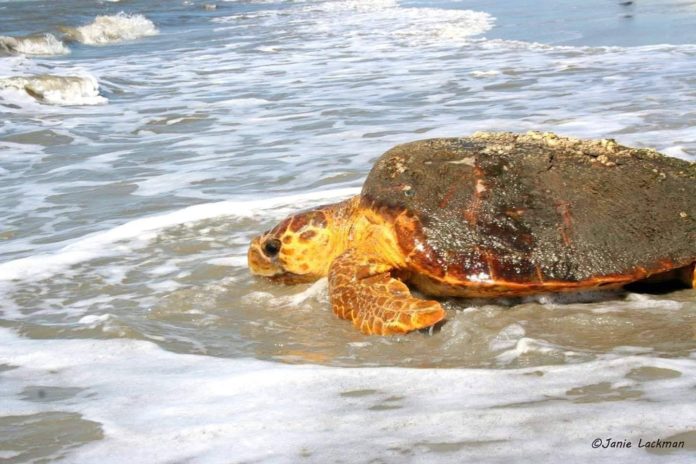Sea turtle season officially starts on May 1st here on local South Carolina beaches. With a record year in 2019, we wonder what will the 2020 sea turtle season bring to the S.C. coast?
And, nobody knows.
It could be a down year because of all of the activity last year. It could be a repeat of last year. Or it could be bigger yet.
The first leatherback sea turtle nest of this year’s nesting season showed up on Florida’s east coast back in mid February….the earliest ever documented sea turtle nest in the state.
Is that a sign? It could be.
Experts agree that the uptick is more females are coming in to nest that are believed to be breeding-age adults born in the 1980s when more stringent nest protection was getting underway.
That means that the conservation efforts have worked.
More than a half million loggerhead sea turtle hatchlings made their way into the ocean from our beautiful South Carolina beaches in 2019. With estimates at 524,518 emerged eggs, sea turtles laid the most nests on South Carolina beaches in 2019 since record keeping began in the early 1980s, according to the S.C. Department of Natural Resources.
It dwarfs any recent year on record. For comparison, 2016 was the previous record nesting year, and it had 396,441 eggs emerge.
A whopping 8,798 loggerhead sea turtle nests were laid last season on state beaches; destroying the previous record of 6,444 set in 2016, which had surpassed the then-previous record of 5,193 set in 2013.
This year, volunteers are getting ready for the new season with excitement, after what they saw last year. Rightfully so. It could be a banner year yet again.
“It is difficult to say what we may expect this nesting season,” said Katrina Rossman, who heads up the turtle patrol on St. Helena Island’s Coffin Point beach. “We hope to have continued upward trends, this will support conservation efforts being effective.”
Soon volunteers from Harbor, Hunting, Pritchard’s, Fripp and St. Helena Island’s Coffin Point beach will be walking the sand in the early mornings.
“Volunteers will start organizing and training in April and will be hitting the beaches daily starting May 1st,” Rossman said.
As sea turtle season approaches, keep in mind that there are so many ways for you to help. Whether or you live near areas where sea turtles are found, are just visiting, or appreciate them from afar, there’s plenty you can do to help these wonderful animals.
Lights out
Sea turtle hatchlings use light and reflections from the moon to find their way to the water at night. Artificial lighting confuses the hatchlings and causes them to head inland instead of out to sea – putting them in dangerous situations which can lead to death. Artificial lights also discourage adult females from nesting on the beach. Short of turning off your lights, you can also take measures to shield, redirect and lower the intensity of the lights on your property.
Keep the beach clean
Sea turtles can become tangled in plastic and trash both on the shore and in the water. Discarded items such as fishing lines, balloons and plastic bags may also be confused for food and eaten by sea turtles, often resulting in injury or death.
Leave turtles alone
How many of you want an audience when you’re giving birth? Honestly? Yes, sea turtles are cute, and therefore they’re tempting to touch and observe, but flashlights and people disturb turtles when they are nesting, or trying to nest. Make sure to give nesting areas plenty of space, and do not disturb females as they emerge from the ocean looking for a place to nest. Also be conscious of where nesting areas are so that you can avoid trampling the hatchlings as they head to the water later in the season.
If you encounter a turtle on the beach at night, remain quiet, still, and at a distance, otherwise she may become frightened and return to the ocean without nesting.
Mind your stuff
Remove recreational equipment, such as lounge chairs, cabanas, umbrellas, and boats, from the beach at night. These items can deter nesting attempts and prevent hatchlings from reaching the ocean.
Put the sand back the way it was
Always level sandcastles at the beach after you’re done enjoying your visit. And, please, fill in those holes. A momma sea turtle doesn’t need to fall into a hole or come face to face with the fortress of Helm’s Deep while she’s struggling to find a nesting spot. This is their environment, no pitfalls or fancy castles are necessary. Don’t give the sea turtles in Beaufort a hard time.
Also, leave tracks left by turtles undisturbed. Researchers use the tracks to identify the species of turtle that nested and to find and mark the nests for protection.
Alert boating
When boating, stay alert and avoid sea turtles. Propeller and collision impacts from boats and ships can result in injury and death of sea turtles. Also, stay in channels and avoid running in seagrass beds to protect this important habitat from prop scarring and damage. Avoid anchoring boats in seagrass beds and coral reefs, which serve as important foraging and resting habitats for sea turtles.
Sea turtle nesting season is a special time here in the Lowcountry. Let’s keep it happening for generations to come.
To follow the S.C. sea turtle season, visit the SCDNR website.










